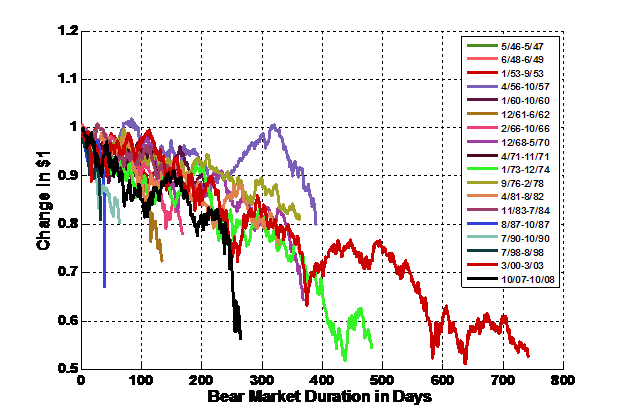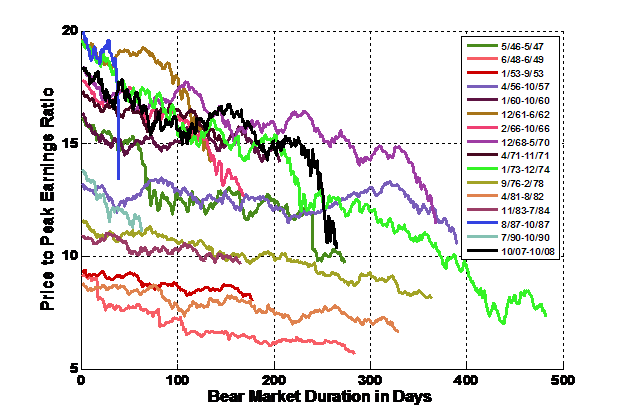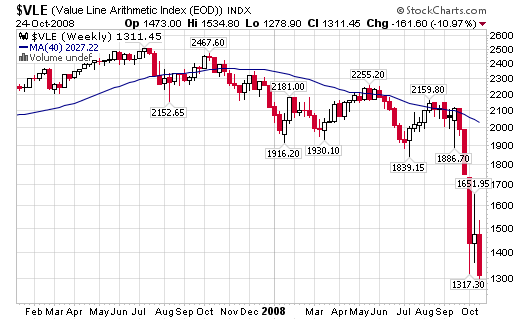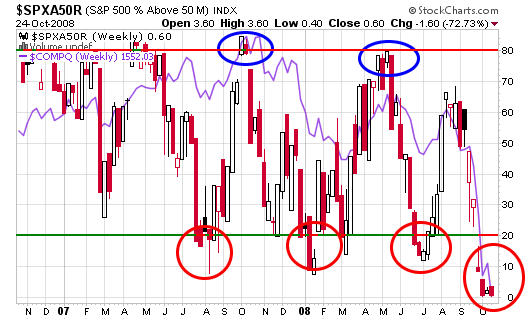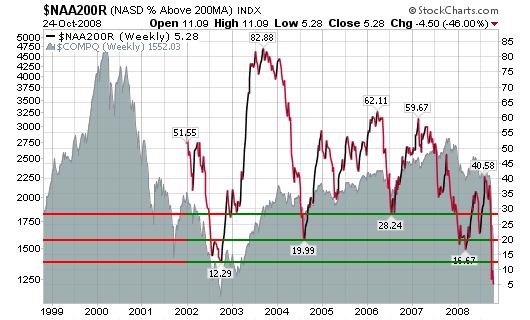Hedge fund drawdown?
Risk management Rule No.1: if it can happen then it will happen. Hope for the best but plan for the worst. Recent events have provided good returns for some hedge funds, hard times for other hedge funds but harsher times for long only. Skilled absolute return managers don't make money every month but they do have milder and shorter duration drawdowns than index funds. I wrote back in January that the Dow and Nikkei would likely fall below 10,000 this year as a result of the credit crisis and owning stock index option puts has indeed been the top performing strategy this year. But those were just lucky guesses. I can't time markets so personally I'll be focusing on funds that can preserve capital, control drawdowns and generate alpha no matter what happens.Flight to quality? Some REAL hedge funds are POSITIVE for the year even when the aggregate returns for the industry are negative. Performance dispersion is enormous in such a diverse universe. Several strategies have NOT been affected by prime brokers imploding, changes in short selling rules or the leverage lockdown. The BEST managed futures CTAs, global macro, high frequency quantitative and options trading strategies have been generating absolute returns throughout the equity and credit mayhem. Strategy diversification is so important since forecasting is difficult, especially about the future. Transitions from one market regime to another often requires a financial revolution.
Crash or capitulation? Dislocated markets create inefficiencies for traders with the rare expertise to exploit them. For anyone predicting a Great Depression, it is worth recalling that hedge fund managers Benjamin Graham, John Maynard Keynes, Karl Karsten, Philip Fisher and Gerald Loeb performed well in the 1930s. And when the 1960s boom ended, even the Buffett Partnership closed down despite good performance but Warren has extracted plenty of alpha subsequently. Similar to some other prominent multistrategy hedge funds, Berkshire Hathaway is down over 25% this year but I have no doubt managers with genuine edges will be back at high water marks before equity benchmarks. Sure there are issues affecting particular strategies but the best managers are able to adapt, learn and ultimately thrive in changed conditions.
Hedge funds are dead. Long live hedge funds. I am long/short optimistic/pessimistic for different strategies. Even in the best conditions only 10% of hedge funds are "buys" and 90% are "sells". If we lose the bottom quartile or two, it will be POSITIVE for the industry. Survival of the fittest. The crowd is usually wrong and seeking alpha requires going against the crowd. Severe losses for stock markets have occurred many times in the past. Plenty of "hedge funds" unable to manage risk or cope with chaos disappeared in 1970, 1974, 1994 and 1998. The more funds that shut down, the better the opportunity set for skilled managers. Economists forecasting the end of hedge funds (again!) should look into how much money was made by people who invested IN hedge funds at the end of 1998 or 1994. Most long biased funds closed as a result of the hard times for hedge funds in 1969 but that had no impact on REAL hedge funds that didn't need a bull market to make money.
Creative destruction is a feature of free markets and there have been several hedge fund shakeouts previously. I don't know the etiology of the market meltdown and credit crisis or speculate on future economic policy initiatives or regulatory solutions. I do know good hedge fund managers are able to evolve in WHATEVER market conditions occur. When business magazines use words like hedge fund extinction, absolute return armageddon or hedge fund apocalypse then capitulation is near. All I can say in response is that out of the hedge funds that I follow, they range from UP a lot to DOWN but much less than long only equity funds.
The FUTURE prospects are negative for some strategies BUT the outlook is attractive for many other strategies. The manager universe is so varied and investment skill so wide ranging that the "average" return is not very informative. Of course the "typical" manager will be down especially with the largest hedge fund category being long biased equity. The independence of a return source and the low covariance of that performance with underlying risk factors is what separates the alpha managers from the beta pack. Keep the powder dry since buying good securities and good hedge funds in a drawdown can turn out to be a good idea.
Alpha is good but leveraged beta is not. Turbulence and turmoil permit talented traders to make money. The PURPOSE of REAL hedge funds is to REDUCE total portfolio volatility. The previous bear period a few years ago when stock markets dropped 50%, money flowed INTO hedge funds for that very reason. Quality hedge funds offer a SMOOTHER ride, lower volatility and less severe drawdowns than long only. Despite the hysteria, the percentage asset allocation to absolute return strategies has actually RISEN this month because more has been lost in the stock market. When a strategy gets too crowded it can make sense to do the opposite. Shorting that "upward drift" of equities and reverse arbitrage have worked well this year.
Markets fluctuate. The revenge of the pessimists has triumphed over the optimists recently. Hedging means expecting and preparing for the unexpected. Reduce risk and PROPERLY diversify BEFORE bad times occur. The beta bubble has burst so the need INCREASES for absolute return strategies that can make money or preserve capital in difficult times. Many equity or credit risk premium funds masquerading as hedge funds have been revealed. Thorough due diligence can detect such bull market reliance in advance. If a fund needs fine conditions to make money there is little point in having it in the portfolio. We can get "good economy" return sources from traditional funds. A real hedge fund should offer something different.
Some might be content to "ride out" another steep stock market drawdown but I don't bet on beta myself. I prefer finding managers with skill at risk management and security selection. Absolute returns from volatile times requires a rare talent with a robust strategy. The pundits could note that some very SOPHISTICATED investors are planning to INCREASE hedge fund allocation in 2009 because they recognize the alpha opportunities that will be available. Most redemptions from losing hedge funds will simply be reinvested in better strategies run by superior managers. If anything the equity and credit meltdown PROVES the case for bona fide alpha generators. Neither hedge funds nor capitalism are facing judgment day. Recent economic eschatology has been misinformed and counterproductive.
Capital should flow to quality strategies as much as quality assets. A properly diversified portfolio can eliminate major drawdowns. Volatility is vicious if a manager is not nimble or too constrained to capture the market anomalies it creates. Commentators try to impose a homogeneity on hedge funds but it is the heterogeneity of strategies and managers that is the value proposition. A good fund below its high water mark is an opportunity but a good manager up for the year is even better. Natural selection and thorough research reveals who those funds are.
I've never found empirical evidence for the "equity risk premium" but "skill-based alpha" is persistent in the hedge fund performance data. The "average" hedge fund has lost money but would anyone seriously expect an AVERAGE fund manager to have made money this year? Recent events PROVE the rarity of skill and the case for strategies that can protect capital in DOWN markets. Alpha is the ability to extract absolute returns out of other market participants. 2 and 20 is worth paying for uncorrelated sources of return but not to funds that need conducive markets and risk premia to make money.
Great depression - no, great delusion - yes. In bull markets the best trade is usually to short sell arrogance and ignorance of risk but in bear markets it can be optimal to buy into pessimism and negativity. With the widespread predictions of depression, we are likely near the end of the panic. Ironically my own long term macro model just switched to bullish after 18 months of bearishness. The beauty of computational intelligence is that it is the complete opposite of computational finance. The caveats are that the black box can be early and the markets could still fall further. An edge does not mean correct all the time. But since it has been short stock indices and long volatility for such an extended period the risk/reward MIGHT now favor the bull case. Not that I have ever invested in a long only equity fund; there are so many arbitrages and mispricings available instead.
Some good hedge funds made money while others have had limited drawdowns during the market meltdown. Many have reduced exposures and moved substantially to cash. A bear market for stocks and credit is the SCENARIO that proves the need for proper diversification. Of course beta dependent unskilled funds are shutting down and being redeemed but that is the Darwinian feature of the business. In contrast quality hedge funds are functioning as a portfolio hedge during difficult times for traditional assets. Despite the temporary problems, top hedge funds will likely offer good long term prospects for risk-adjusted absolute returns. That was true 1929-2008 and I would be pretty confident of similar for 2009-2088.
 Written before yesterday's sharp rise, stock market historian and advisor
Written before yesterday's sharp rise, stock market historian and advisor 



 Stephen Schiff isn’t a trader or a banker, but he knows first-hand about the convulsions on Wall Street. He is the screenwriter who wrote was was supposed to be Gordon Gekko’s
Stephen Schiff isn’t a trader or a banker, but he knows first-hand about the convulsions on Wall Street. He is the screenwriter who wrote was was supposed to be Gordon Gekko’s 